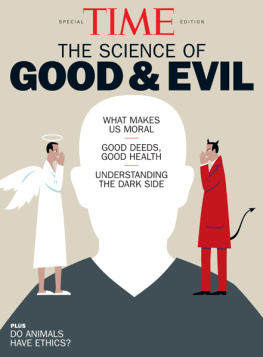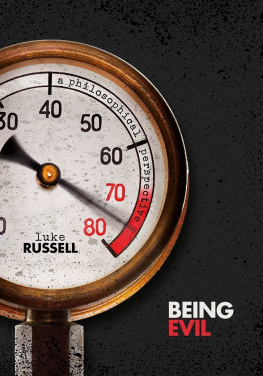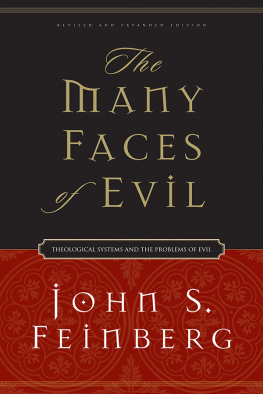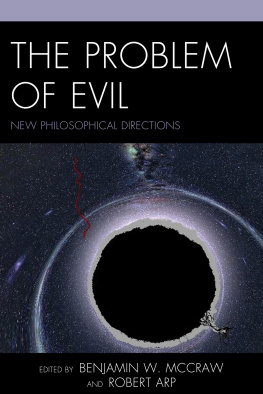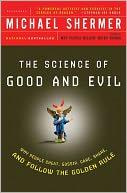CHAPTER 1
Introduction: The Problem and the Approach
Evil factsare a genuine portion of reality; and they may after all be the best key to lifes significance and possibly the only openers of our eyes to the deepest levels of truth.
W ILLIAM J AMES, Varieties of Religious Experience
1.1 What Is Evil?
Evil has an ominous connotation that goes beyond badness. It is perhaps the most severe succinct condemnation our moral vocabulary affords, so it should not be used casually and the conditions of its justified ascription should be made clear. Evil involves serious harm that causes fatal or lasting physical injury, as do, for instance, murder, torture, and mutilation. Serious harm need not be physical. But since judging the seriousness of nonphysical harm, such as loss of honor, happiness, or love, involves complex questions, I shall concentrate on simple cases of physical harm whose seriousness is as obvious as it is of losing life, limb, or eye-sight, or suffering prolonged excruciating pain. Serious harm may be caused by natural disasters, animals, or viruses; and human beings may cause serious harm to the fauna or the flora. Nevertheless, evil has primarily to do with serious harm caused by human beings to other human beings. This may be excusable on moral grounds as self-defense, deserved punishment, necessary for averting worse harm, or as resulting from nonculpable ignorance, unavoidable accident, or unforeseeable contingencies. Part of what makes human actions evil, then, is that they cause serious harm and lack excuse.
The harm involved in evil actions is not just serious but also excessive. This is part of the reason why such actions are worse than morally bad. To rob someone at gunpoint is morally bad, but after having gotten the money, to torture, mutilate, and then murder the victim is evil. Evildoers cause more serious harm than is needed for achieving their ends. They are not just unscrupulous in their choice of means, but motivated by malevolence to gratuitous excesses. They treat their victims with ill will, rage, or hatred. This may be shown by the sheer quantity of the harm they do, as in the murder of thousands of innocent victims, or by the quality of their actions, such as torturing children. Evil actions go beyond breaking some ordinary moral rule; they show contempt for and flaunt fundamental moral prohibitions.
The evil of an action, therefore, consists in the combination of three components: the malevolent motivation of evildoers; the serious, excessive harm caused by their actions; and the lack of morally acceptable excuse for the actions. Each of these components is necessary, and they are jointly sufficient for condemning an action as evil. An action may cause serious, excessive harm and not be evil if, for instance, it is accidental, coerced, or morally justified. Nor is malevolent motivation enough to make an action evil because as a result of unexpected circumstancesthe bomb failed to explode, the gun misfiredthe action may fail to cause any harm. Furthermore, an action prompted by malevolent motivation and causing serious, excessive harm may still not be evil if it is morally excusable by being, for example, justified punishment or necessary for avoiding even greater harm. The justified ascription of evil to an action requires, therefore, motive, consequence, and lack of excuse.
Each of these components allows for degrees: malevolent motives may range from short-term blind rage to a lifelong hatred of humanity; serious, excessive harm may involve the torture and murder of one innocent victim or doing the same to thousands; and a morally inexcusable action may fall anywhere on a continuum from culpable ignorance or weakness to deliberately and knowingly doing evil for its own sake. The justified ascription of evil to actions, therefore, allows for a distinction between levels of evil. People can be said to be evildoers if they habitually perform evil actions, and they can be greater or lesser evildoers depending on the level of evil they do. And institutions, societies, and other collectives are evil derivatively twice over if they lead their participants to cause various degrees of evil.
Evil actions violate their victims physical security and thus transgress fundamental moral prohibitions that protect minimum conditions of human well-being. One essential task of morality is to safeguard these conditions. Evildoers or their defenders sometimes attempt to excuse evil Nor is it deniable that most of this evil is caused by human beings. The problem is to explain why they cause it.
1.2 Approaches to Explanation
There is no shortage of attempts to provide an explanation. My reason for adding to their number is that the most influential previous onesthose inspired by the religious and the Enlightenment world viewstry to explain evil by explaining it away. They deny what the epigraph rightly asserts, namely, that evil factsare a genuine portion of reality. Both begin with a world view and then try to fit evil into it. But evil does not fit, and that is why they try to explain it away. A detailed discussion of these explanations and their shortcomings will follow, but a brief indication of what they are is needed here to contrast my approach with theirs.
A dominant tendency in the religious world view is to assume that a morally good order permeates the scheme of things and human lives go well to the extent to which they conform to it. The problem of evil, then, becomes the problem of explaining the failure to conform. There are various religious explanations, but most of them assume that the failure results from the misuse of the evildoers reason or will. Evil is thus seen as a defect in evildoers rather than in the scheme of things. This explanation faces two difficulties its defenders have not succeeded in overcoming despite many centuries of trying. One is to justify the belief that although experience and history provide abundant contrary evidence, there is a morally good order in the scheme of things. The other is that since human beings are part of the scheme of things, any defect in evildoers is a defect in the scheme of things. The very existence of evil thus constitutes a reason against believing in a morally good order.
A central thread in the Enlightenment world view is the belief that human beings are basically good and their well-being depends on living according to reason. The more reasonable lives are, the better they are supposed to become. The problem of evil is thus the problem of explaining our failure to be more reasonable when it is in our interest to be so. The explanation is that external influences, usually in the form of bad political arrangements, corrupt our basic goodness. Evil is thus explained as the result of interference with our basic goodness. But what reason is there for supposing that human beings are basically good? There obviously are many bad human propensities, and they often overwhelm the good ones. Why suppose that good ones are basic and bad ones are not? Furthermore, if the corruption of our supposed basic goodness is the result of bad political arrangements, it needs to be explained how these arrangements become bad. They are made and maintained by human beings. If they are bad, it is because those who make and maintain them are bad. The ubiquity of bad political arrangements is thus a reason for doubting basic human goodness, not an explanation of evil.
These two approaches differ in many ways, but they share the assumption that the good is basic and evil is derivative because it is some kind of interference with the good. The explanation they seek, therefore, is of the nature and cause of the interference. In my view, this is to seek the explanation of evil in the wrong place because the assumption underlying the search is mistaken. I shall argue that there is no convincing reason for supposing that the good is basic and evil is derivative and there is no more reason to think that evil is interference with the good than that good is interference with evil.


